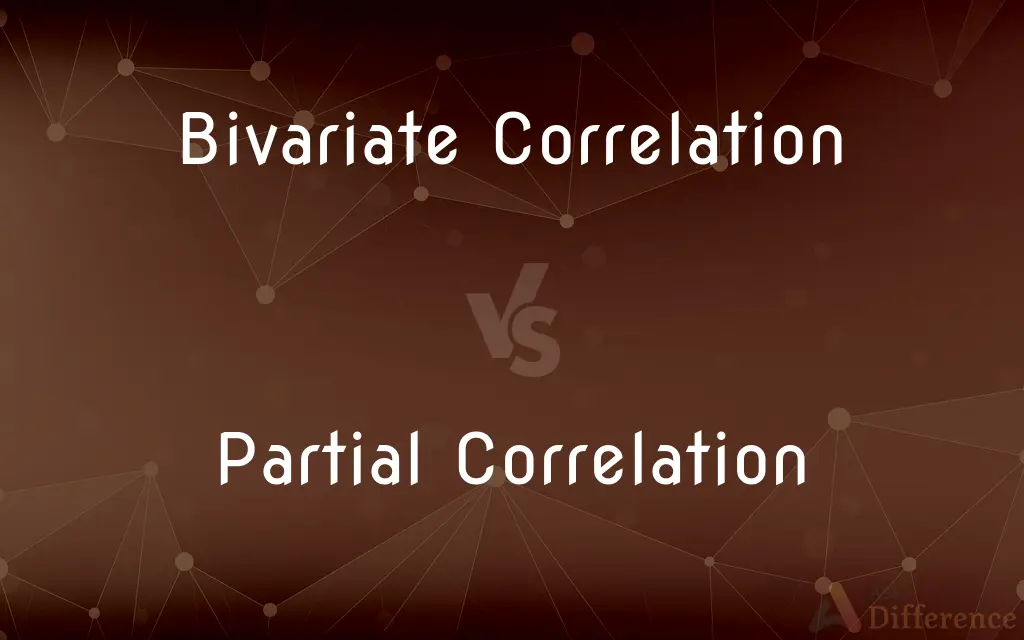Bivariate Correlation vs. Partial Correlation — What's the Difference?
Edited by Tayyaba Rehman — By Fiza Rafique — Published on November 17, 2023
Bivariate Correlation measures the linear relationship between two variables. Partial Correlation measures the relationship between two variables while controlling for one or more other variables.

Difference Between Bivariate Correlation and Partial Correlation
Table of Contents
ADVERTISEMENT
Key Differences
Bivariate Correlation is a statistical measure that gives information about the strength and direction of the linear relationship between two variables. In contrast, Partial Correlation assesses the degree and direction of association between two variables while keeping other variables constant.
When researchers want a simple understanding of how two variables relate, they employ Bivariate Correlation. On the other hand, Partial Correlation is used when there is a need to understand the correlation between two variables excluding the influence of one or more additional variables.
Bivariate Correlation offers a straightforward perspective, showing if, as one variable increases, the other tends to increase (positive correlation) or decrease (negative correlation). Partial Correlation, however, delves deeper, revealing the unique relationship between two variables beyond external influences.
In the realm of research, Bivariate Correlation is essential for initial exploratory analysis. Conversely, when complexities arise from the potential influence of external variables, researchers lean towards Partial Correlation.
Both Bivariate Correlation and Partial Correlation yield values between -1 and 1. While the former solely represents the relationship between two variables, the latter uncovers relationships masked by other intervening variables.
ADVERTISEMENT
Comparison Chart
Definition
Measures linear relationship between two variables.
Measures relationship between two variables, controlling others.
Number of Variables
Involves two variables.
Involves three or more variables.
Influence
Doesn't control for other variables.
Controls for one or more other variables.
Usage
Initial exploratory analysis.
Complex studies with potential confounders.
Depiction of Relationship
Direct relationship between variables.
Unique relationship beyond external influences.
Compare with Definitions
Bivariate Correlation
Requires no control for intervening variables.
Bivariate Correlation was used to see the direct link between caffeine consumption and alertness.
Partial Correlation
A correlation between two variables while controlling for other variables.
The Partial Correlation between income and happiness, controlling for age, was significant.
Bivariate Correlation
Indicates the strength and direction of a straight-line relationship.
Using Bivariate Correlation, researchers found a negative relationship between stress and sleep quality.
Partial Correlation
Gives the unique relationship between two variables, removing external influences.
Using Partial Correlation, researchers isolated the link between diet and health, controlling for exercise habits.
Bivariate Correlation
A statistical measure of the linear association between two variables.
The Bivariate Correlation between study hours and grades was strong and positive.
Partial Correlation
Measures the direct effect between two variables, setting other variables constant.
Partial Correlation revealed the relationship between job satisfaction and productivity, independent of salary.
Bivariate Correlation
Provides a coefficient value between -1 and 1 to depict association.
A Bivariate Correlation of -0.8 suggests a strong inverse relationship.
Partial Correlation
Often used when external variables might confound a relationship.
To exclude the influence of genetics, a Partial Correlation was done between environment and specific traits.
Bivariate Correlation
Essential for preliminary exploration in research.
To understand the initial patterns, a Bivariate Correlation was conducted between age and physical activity.
Partial Correlation
Requires at least three variables, two of interest and at least one control variable.
A study used Partial Correlation to examine the tie between sleep and academic performance, controlling for health.
Common Curiosities
What is the main purpose of Bivariate Correlation?
Bivariate Correlation determines the strength and direction of the linear relationship between two variables.
Can Bivariate Correlation have values outside -1 and 1?
No, Bivariate Correlation values range between -1 (perfect negative correlation) and 1 (perfect positive correlation).
Is Partial Correlation more complex than Bivariate Correlation?
Yes, because Partial Correlation accounts for the influence of one or more other variables.
What's a notable difference between Bivariate Correlation and Partial Correlation?
Bivariate Correlation examines two variables directly, while Partial Correlation considers the relationship by controlling external variables.
When should researchers use Partial Correlation?
They should use Partial Correlation when they want to understand the relationship between two variables while controlling for other variables' influence.
Why is it important to understand these correlations in research?
They help in understanding relationships, making predictions, and uncovering patterns in data.
Can Partial Correlation provide clearer insights in some cases?
Yes, especially when external variables might mask or distort the true relationship between two variables of interest.
Does Bivariate Correlation imply causation?
No, correlation does not imply causation. It only shows a relationship.
Can you control for multiple variables in Partial Correlation?
Yes, you can control for multiple variables to uncover the unique relationship between two primary variables.
How is the strength of a Partial Correlation determined?
Like Bivariate Correlation, its strength is determined by its coefficient value, closer to -1 or 1 being stronger.
Are there specific statistical tests for these correlations?
Yes, commonly the Pearson correlation coefficient for Bivariate Correlation and a controlled version of it for Partial Correlation.
Can both correlations be visualized?
Yes, often using scatter plots for Bivariate Correlation and controlled scatter plots or partial regression plots for Partial Correlation.
Are there other types of correlations besides these two?
Yes, there's also Spearman's rank correlation, Kendall's tau, and others, suitable for different data types and relationships.
Is Bivariate Correlation appropriate for non-linear relationships?
No, it measures linear relationships. Non-linear associations require different methods.
Can these correlations be calculated using software?
Yes, software like SPSS, R, and Python libraries can calculate both Bivariate and Partial Correlations.
Share Your Discovery

Previous Comparison
Quantum Physics vs. Particle Physics
Next Comparison
HTML vs. CSSAuthor Spotlight
Written by
Fiza RafiqueFiza Rafique is a skilled content writer at AskDifference.com, where she meticulously refines and enhances written pieces. Drawing from her vast editorial expertise, Fiza ensures clarity, accuracy, and precision in every article. Passionate about language, she continually seeks to elevate the quality of content for readers worldwide.
Edited by
Tayyaba RehmanTayyaba Rehman is a distinguished writer, currently serving as a primary contributor to askdifference.com. As a researcher in semantics and etymology, Tayyaba's passion for the complexity of languages and their distinctions has found a perfect home on the platform. Tayyaba delves into the intricacies of language, distinguishing between commonly confused words and phrases, thereby providing clarity for readers worldwide.











































